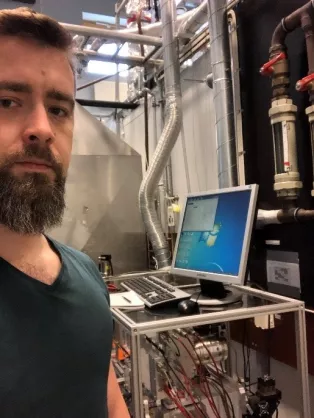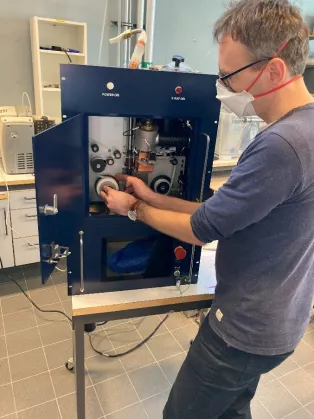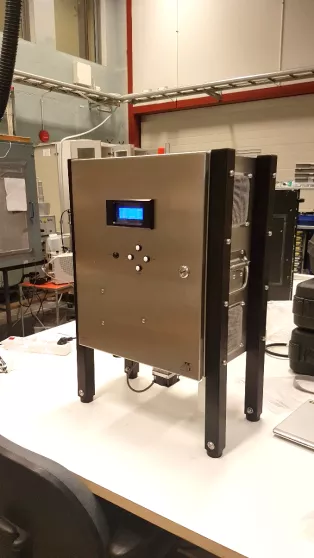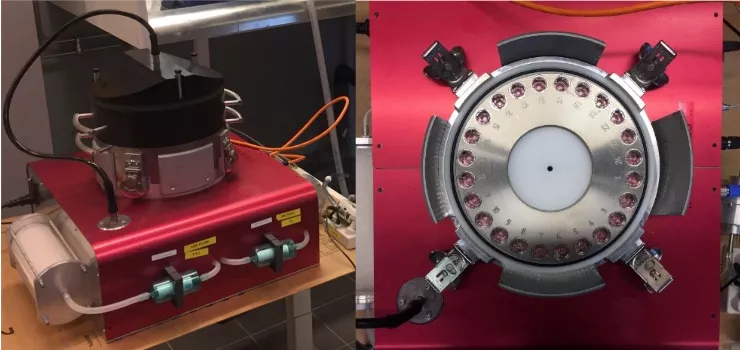Aerosollab
Characterization of airborne nanoparticles
The Aerosol Laboratory is equipped with state-of-the-art tools for physical, chemical, and biological characterization of airborne nanoparticles and is open for collaborations in nanoscience and nanosafety. The 400 m2 laboratory provides ample opportunity for transient set-ups, and additionally, the tools are all mobile enough to be brought to other locations. In 2022 the laboratory installed two new advanced and world-unique chambers by combining techniques from thermal climate and aerosol research. The chambers are room size (total volume around 64 m3) with inner surfaces of stainless steel to enable precise control of environmental parameters and airborne particles. We will extend our possibilities to perform aerosol studies from only normal indoor room conditions in today’s chamber to -25 to +50 °C and RH from 10% to 90% with high precisions in the new chamber. Through this, we will have improved possibilities to perform aerosol research in many fields, including nanosafety and science.
Many experimental techniques are available: from standard instrumentation for size and concentration measurements of airborne nanoparticles to more specialized equipment. We operate condensation particle counters for total number particle concentration, scanning mobility particle sizers for precision measurements of particle size distributions, and a fast mobility spectrometer which produces highly time-resolved size measurements (1 Hz). Below are four examples of more specialized tools. The laboratory can help with all things related to aerosols.
More information at https://www.design.lth.se/english/the-department/research-laboratories/…
Contact axel [dot] eriksson [at] design [dot] lth [dot] se
Aerosol Mass Spectrometry (AMS)
Airborne particles in the size range 60-1000 nm are focused by means of an aerodynamic lens and subsequently vaporized. The vapors are introduced to a mass spectrometer, which enables highly time and size resolved (10 Hz) measurements of particle chemical composition.
- Particle time-of-flight for sizing
- Particle vaporisation: impaction on W plate heated to 600 C, or Nd:YAG intracavity laser (1064nm), >0.2 MW/cm2
- Electron impact ionization
- Time-of-flight mass spectrometer resolution ~2000 at 28 Th
Publications
Nilsson, P.T, et al (2015). In-situ characterization of metal nanoparticles and their organic coatings using laser vaporization aerosol mass spectrometry. Nano Reseach. 8(12). p.3780-3795. Doi:10.1007/s12274-015-0877-9
Nilsson, P.T., et al. (2013). Nano-objects emitted during maintenance of common particle generators: direct chemical characterization with aerosol mass spectrometry and implications for risk assessments. J Nanopart Res, 15(11), doi: 10.1007/s11051-013-2052-0
Elemental composition monitor (Xact)
Measures elemental abundances through X-ray Fluorescence Spectroscopy (XRF). The aerosol is drawn though a filter reel. After deposition the filter reel is advanced and the recently collected filter spot is irradiated to facilitate near real time XRF.
- Sampling, analysis, and near real-time reporting (every 15, 30, 60, 120, 180, or 240 minutes in ng/m³)
- Internal XRF quality assurance standard with every sample analyzed
- Automatic, daily XRF calibration drift checks
- Covers typical technologically relevant elements
BioSpot – bioaerosol collection
Collects aerosol particles at a wide range (down to 5 nm) with high efficiency. The instrument condensates water onto aerosol particles which are then collected by impaction on a liquid surface. This technique is beneficial for studies of airborne viruses and bacteria (bioaerosols) as the collection is gentle for microorganisms.
- Condensation particle collection
- Aerosol particle collection into liquid
- >93% collection efficiency down to 5 nm particles
- 8 liters of air per minute
- 1.5 - 4 mL collection liquid
Nano Aerosol Chamber for In Vitro Toxicity (NACIVT)
Set-up for toxicity testing of airborne particles. The particles are deposited onto cell cultures (for example small airway epithelial cells) directly from the aerosol phase, mimicking real life respiratory exposure.
- Electrostatic deposition of nanoparticles – with deposition fractions similar to human lungs
- Controlled temperature and relative humidity ensure biological conditions
- Table-top size and transportable – can be used for in vitro studies e.g. at workplaces
- Collected particles from any environment can be re-aerosolized and used in the NACIVT
Publications
Lovén K., et al. (2021). Toxicological effects of zinc oxide nanoparticle exposure: an in vitro comparison between dry aerosol air-liquid interface and submerged exposure systems. Nanotoxicology DOI: 10.1080/17435390.2021.1884301
Svensson, C.R. et al (2016). Validation of an air–liquid interface toxicological set-up using Cu, Pd, and Ag well-characterized nanostructured aggregates and spheres. J Nanopart Res 18:86DOI 10.1007/s11051-016-3389-y





